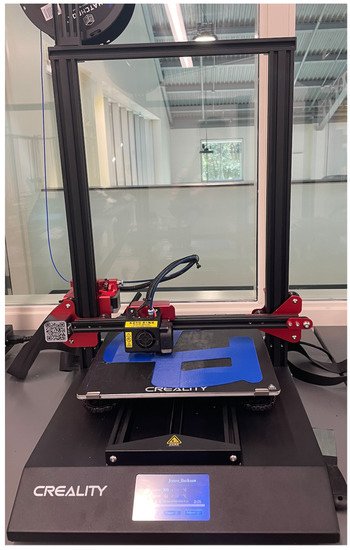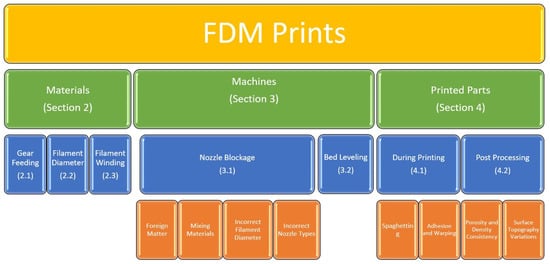The potential failures and flaws associated with fused deposition modeling (FDM) or fused filament fabrication (FFF) 3D printing technology are highlighted. The focus is on presenting the failures and flaws that are caused by the operational standpoints and which are based on the many years of experience with current and emerging materials and equipment for the 3D printing of polymers and composites using the FDM/FFF method. FDM or FFF 3D printing, which is also known as an additive manufacturing (AM) technique, is a material processing and fabrication method where the raw material, usually in the form of filaments, is added layer-by-layer to create a three-dimensional part from a computer designed model.
- fused deposition modeling (FDM)
- fused filament fabrication (FFF)
- polylactic acid (PLA) filament
- acrylonitrile butadiene styrene (ABS) filament
- nondestructive testing (NDT)
- 3D printing
- additive manufacturing (AM)
1. Introduction
1.1. Fused Deposition Modeling (FDM) as a Cost-Effective Alternative to Traditional Manufacturing

1.2. Common Defects Posed by FDM Printing
1.2.1. Thermal Inconsistencies Affecting Part Fabrication
1.2.2. Fiber-Related Defects in Composites

2. Nondestructive Testing (NDT) Methods
2.1. Nondestructive Testing in the Process
2.2. Nondestructive Testing after the Process
This entry is adapted from the peer-reviewed paper 10.3390/jcs6070202
References
- . "Cubify Cube Store." Retrieved 06/12, 2022, from http://cubify.com/cube/store.aspx.
- . "Makerbot Replicator." Retrieved 06/12, 2022, from http://store.makerbot.com/replicator.
- . "Makerbot Replicator Mini." Retrieved 06/12, 2022, from http://store.makerbot.com/replicator-mini.
- "Matterhackers."
- Abdelrahman, M. a. S., T.L. (2016). "Quality certification and control of polymer laser sintering: layerwise temperature monitoring using thermal imaging." The International Journal of Advanced Manufacturing Technology 84: 831-842.
- Ahmad, M. N., et al. (2022). "Application of Taguchi Method to Optimize the Parameter of Fused Deposition Modeling (FDM) Using Oil Palm Fiber Reinforced Thermoplastic Composites." Polymers 14(11): 2140.
- Ahmed, S. W., et al. (2020). "On the Effects of Process Parameters and Optimization of Interlaminate Bond Strength in 3D Printed ABS/CF-PLA Composite." Polymers 12(9): 2155.
- Albakri, M. I., Sturm, L.D., Williams, C.B., and Tarazaga, P.A. (2017). "Impedance-based non-destructive evaluation of additively manufactured parts." Rapid Prototyping Journal 23: 589-601.
- Alves, M., et al. (2021). "Fiber waviness and its effect on the mechanical performance of fiber reinforced polymer composites: An enhanced review." Composites Part A: Applied Science and Manufacturing 149: 106526.
- Arkhurst, B. M., et al. (2019). "Interfacial structure and bonding mechanism of AZ31/carbon-fiber-reinforced plastic composites fabricated by thermal laser joining." Composites Part B-Engineering 167: 71-82.
- Arrigo, R. and A. Frache (2022). "FDM Printability of PLA Based-Materials: The Key Role of the Rheological Behavior." Polymers 14(9): 15.
- Bednarcyk, B. A., et al. (2014). "The effect of general statistical fiber misalignment on predicted damage initiation in composites." Composites Part B: Engineering 66: 97-108.
- Bernal, J. D. B., et al. (2019). "Characterization of effective Young's modulus for Fused Deposition Modeling manufactured topology optimization designs." International Journal of Advanced Manufacturing Technology 103(5-8): 2879-2892.
- Bhagia, S., Bornani, K., Agrawal, R., Satlewal, A., Ďurkovič, J., Lagaňa, R., Bhagia, M., Yoo, C.G., Zhao, X., Kunc , V., Pu, Y., Ozcan, S., and Ragauskas, A.J. (2021). "Critical review of FDM 3D printing of PLA biocomposites filled with biomass resources, characterization, biodegradability, upcycling and opportunities for biorefineries." Applied Materials Today 24: 101078.
- Blanco, I. (2020). "The use of composite materials in 3D printing." Journal of Composites Science 4(2): 42.
- Bond, L. J., Koester, L.W., Taheri, H. (2019). NDE in-process for metal parts fabricated using powder based additive manufacturing. Smart Structures and NDE for Energy Systems and Industry 4.0: 1 , publisher = SPIE.
- Borish, M., Post, B.K., Roschli, A., Chesser, P.C., and Love, L.J. (2020). "Real-Time Defect Correction in Large-Scale Polymer Additive Manufacturing via Thermal Imaging and Laser Profilometer." Procedia Manufacturing 48: 625-633.
- Fan, C. Z., et al. (2021). "Interfacial Bonding Mechanism and Mechanical Performance of Continuous Fiber Reinforced Composites in Additive Manufacturing." Chinese Journal of Mechanical Engineering 34(1): 11.
- Finnes, T. (2015). "High Definition 3D Printing-Comparing SLA nad FDM Printing Technologies." The Journal of Undergraduate Research 13: 10-26.
- Gibson, I., Rosen, D., Stucker, B., and Khorasani, M. (2020). Additive Manufacturing Technologies.
- Giesko, T., Zbrowski, A., and Czajka, P. (2007). "Laser Profilometers for Surface Inspection and Profile Measurement." Problemy Eksploatacji: 97-108.
- Groover, M. P. (2022). Fundamentals of Modern Manufacturing.
- Harris, M., et al. (2022). "Partial Biodegradable Blend with High Stability against Biodegradation for Fused Deposition Modeling." Polymers 14(8): 17.
- Hassanifard, S. and K. Behdinan (2022). "Effects of voids and raster orientations on fatigue life of notched additively manufactured PLA components." International Journal of Advanced Manufacturing Technology 120(9-10): 6241-6250.
- Jin, Y., Wan, Y., Zhang, B., and Liu, Z. (2017). "Modeling of the chemical finishing process for polylactic acid parts in fused deposition modeling and investigation of its tensile properties." Journal of Materials Processing Technology 240: 233-239.
- Kafle, A., Luis, E., Silwal, R., Pan, H.M., Shrestha, P.L., and Bastola, A.K. (2021). "3D/4D Printing of Polymers: Fused Deposition Modelling (FDM), Selective Laser Sintering (SLS), and Stereolithography (SLA)." Polymers 13: 3101.
- Kalsoom, U., et al. (2016). "Recent developments in 3D printable composite materials." RSC advances 6(65): 60355-60371.
- Kidangan, R. T., et al. (2021). "Identification of the fiber breakage orientation in carbon fiber reinforced polymer composites using induction thermography." NDT & E International 122: 102498.
- Koester, L. W., Taheri, H., Bond, L.J., Barnard, D., and Gray, J. (2016). Additive manufacturing metrology: State of the art and needs assessment. AIP Conference Proceedings: 130001.
- Koester, L. W., Bond, L.J., Taheri, H., and Collins, P.C. (2018). "Nondestructive Evaluation of Additively Manufactured Metallic Parts." Nondestructive Evaluation of Materials: 544-552 , publisher = ASM International.
- Koester, L. W., Bond, L.J., Taheri, H., and Peter C. Collins, P.C. (2018). "Nondestructive evaluation of additively manufactured metallic parts: in situ and post deposition." Additive Manufacturing for the Aerospace Industry: 401-417 , publisher = Elsevier.
- Koester, L. W., Taheri, H., Bigelow, T., Collins, P.C., and Bond, L.J. (2018). "Nondestructive Testing for Metal Parts Fabricated Using Powder-Based Additive Manufacturing." Materials Evaluation 76: 514-528.
- Kugler, D. and T. J. Moon (2002). "Identification of the most significant processing parameters on the development of fiber waviness in thin laminates." Journal of composite Materials 36(12): 1451-1479.
- Kuo, C. C., et al. (2019). "Minimizing warpage of ABS prototypes built with low-cost fused deposition modeling machine using developed closed-chamber and optimal process parameters." International Journal of Advanced Manufacturing Technology 101(1-4): 593-602.
- Lee, J., Hasanian, M., Saboonchi, H., Baechle, M., and Taheri, H. (2020). Ultrasonic evaluation of polymer additively manufactured parts for defect inspection and structural integrity assessment. Nondestructive Characterization and Monitoring of Advanced Materials, Aerospace, Civil Infrastructure, and Transportation IX: 70 , publisher = SPIE.
- Li, Y., et al. (2016). "The effect of fiber misalignment on the homogenized properties of unidirectional fiber reinforced composites." Mechanics of Materials 92: 261-274.
- Liao, Y., Liu, C., Coppola, B., Barra, G., Di Maio, L., Incarnato, L., and Lafdi, K. (2019). "Effect of Porosity and Crystallinity on 3D Printed PLA Properties." Polymers 11: 1487.
- Lin, T., et al. (2008). "Effects of fiber length on mechanical properties and fracture behavior of short carbon fiber reinforced geopolymer matrix composites." Materials Science and Engineering: A 497(1-2): 181-185.
- Liu, T., et al. (2022). "Predictions of the axial tensile property of the unidirectional composite influenced by microfiber breakage defects." Textile Research Journal 92(1-2): 15-29.
- Nazan, M. A., Ramli, F.R., Alkahari, M.R., Sudin, M.N., and Abdullah, M.A. (2016). "Optimization of Warping Deformation in Open Source 3D Printer Using Response Surface Method." Proceedings of Mechanical Engineering Research Day 2016: 71-72.
- Nazan, M. A., Ramli, F.R., Alkahari, M.R., Abdullah, M.A., and Sudin, M.N. (2017). "An exploration of polymer adhesion on 3D printer bed." IOP Conference Series: Materials Science and Engineering 210: 012062.
- Nguyen, H. T., et al. (2022). "Experimental Modal Analysis and Characterization of Additively Manufactured Polymers." Polymers 14(10): 18.
- Park, M. J., et al. (2022). "Structural Behavior of a Composite Curtain Wall Fabricated by the Fused Deposition Modeling 3D Printing Method." Polymers 14(7): 20.
- Pervaiz, S., et al. (2021). "3D Printing of Fiber-Reinforced Plastic Composites Using Fused Deposition Modeling: A Status Review." Materials 14(16): 4520.
- Sauerbrunn, E., Chen, Y. Didion, J., Yu, M., Smela, E., and Bruck, H.A. (2015). "Thermal imaging using polymer nanocomposite temperature sensors." physica status solidi (a) 212: 2239-2245.
- Sehhat, M. H., et al. (2022). "Impact of temperature and material variation on mechanical properties of parts fabricated with fused deposition modeling (FDM) additive manufacturing." International Journal of Advanced Manufacturing Technology 120(7-8): 4791-4801.
- Senthil, K., et al. (2013). "Defects in composite structures: Its effects and prediction methods–A comprehensive review." Composite Structures 106: 139-149.
- Senthil, K., et al. (2013). "Defects in composite structures: Its effects and prediction methods–A comprehensive review." Composite Structures 106: 139-149.
- Shanmugam, V., et al. (2021). "Fatigue behaviour of FDM-3D printed polymers, polymeric composites and architected cellular materials." International Journal of Fatigue 143: 15.
- Shmueli, Y., Jiang, J., Zhou, Y., Xue, Y., Chang, C. Yuan, G., Satija, S.K., Lee, S., Nam, C., Kim, T., Marom, G., Gersappe, D., and Rafailovich, M.H. (2019). "Simultaneous in Situ X-ray Scattering and Infrared Imaging of Polymer Extrusion in Additive Manufacturing." ACS Applied Polymer Materials 1: 1559-1567.
- Singh, R., Singh, S., and Mankotia, K. (2016). "Development of ABS Based Wire as Feedstock Filament of FDM for Industrial Applications." Rapid Prototyping Journal 22: 300-310.
- Swetham, T., Reddy, K.M.M. Huggi, A., and Kumar, M.N. (2017). "A Critical Review on of 3D Printing Materials and Details of Materials Used in FDM." International Journal of Scientific Research in Science, Engineering, and Technology 3.
- Szykiedans, K. a. C., W. (2016). "Mechanical Properties of FDM and SLA Low-cost 3-D Prints." Procedia Engineering 136: 257-262.
- Taheri, H. (2014). "Utilization of Non-destructive Testing (NDT) Methods for Composite Materials Inspection (Phased Array Ultrasonic)."
- Taheri, H., Du, J., and Delfanian, F. (2017). "Experimental Observation of Phased Array Guided Wave Application in Composite Materials." Materials Evaluation 75: 1308-1316.
- Taheri, H. (2018). "Nondestructive Evaluation and In-Situ Monitoring for Metal Additive Manufacturing." 61-75.
- Taheri, H., Koester, L.W., Bigelow, T.A., Faierson, E.J., and Bond, L.J. (2019). "In Situ Additive Manufacturing Process Monitoring With an Acoustic Technique: Clustering Performance Evaluation Using K-Means Algorithm." Journal of Manufacturing Science and Engineering 141.
- Taheri, H. a. H., A.A. (2019). "Nondestructive Ultrasonic Inspection of Composite Materials: A Comparative Advantage of Phased Array Ultrasonic." Applied Sciences 9: 1628.
- Taheri, H. K., L., Bigelow, T., Bond, L.J., Braconnier, D., Carcreff, E., Dao, G., Caulder, A., and Hassen, A.A. (2018). Fast Ultrasonic Imaging with Total Focusing Method (TFM) for Inspection of Additively Manufactured Polymer Composite Component. ASNT 27th Annual Research Symposium Proceedings: 212-220 , publisher = ASNT.
- Thor, M., et al. (2020). "Mechanisms of origin and classification of out-of-plane fiber waviness in composite materials—a review." Journal of Composites Science 4(3): 130.
- Triyono, J., Sukanto, H., Saputra, R.M., and Smaradhana, D.F. (2020). "The effect of nozzle hole diameter of 3D printing on porosity and tensile strength parts using polylactic acid material." Open Engineering 10: 762-768.
- Wickramasinghe, S., Do, T., and Tran, P. (2020). "FDM-Based 3D Printing of Polymer and Associated Composite: A Review on Mechanical Properties, Defects and Treatments." Polymers 12: 1529.
- Yang, C. C., et al. (2017). "3D printing for continuous fiber reinforced thermoplastic composites: mechanism and performance." Rapid Prototyping Journal 23(1): 209-215.
- Zhao, H., et al. (2019). An Overview of Research on FDM 3D Printing Process of Continuous Fiber Reinforced Composites. Journal of Physics: Conference Series, IOP Publishing.
- Zhu, Q., et al. (2022). "Rapid residual stress prediction and feedback control during fused deposition modeling of PLA." International Journal of Advanced Manufacturing Technology 118(9-10): 3229-3240.
